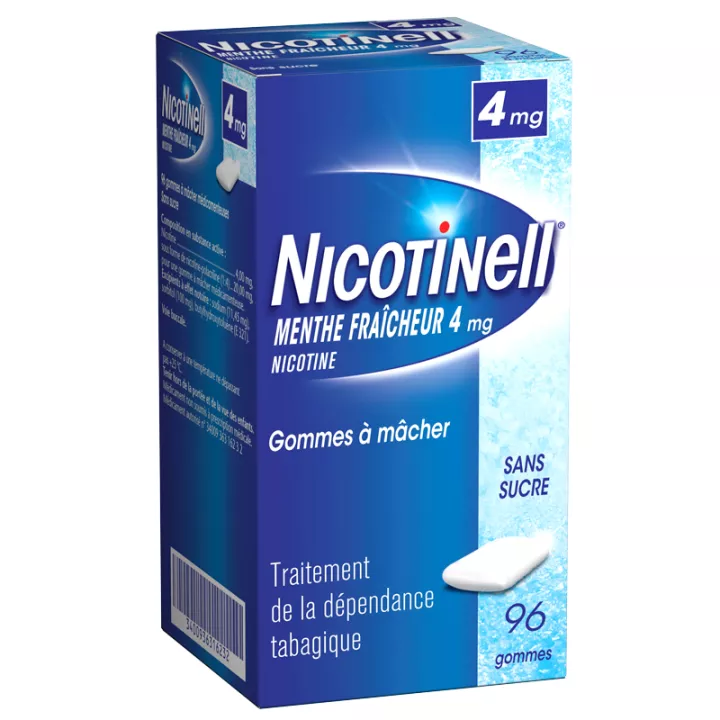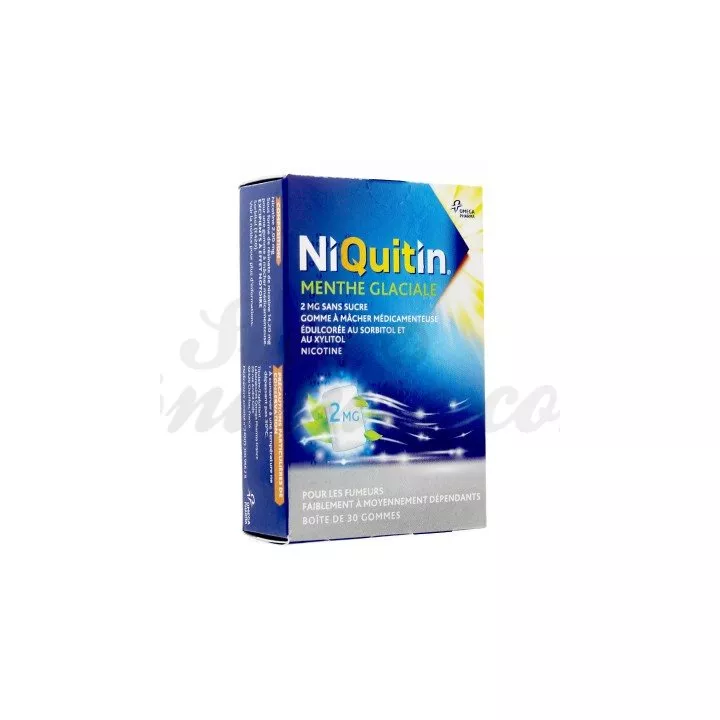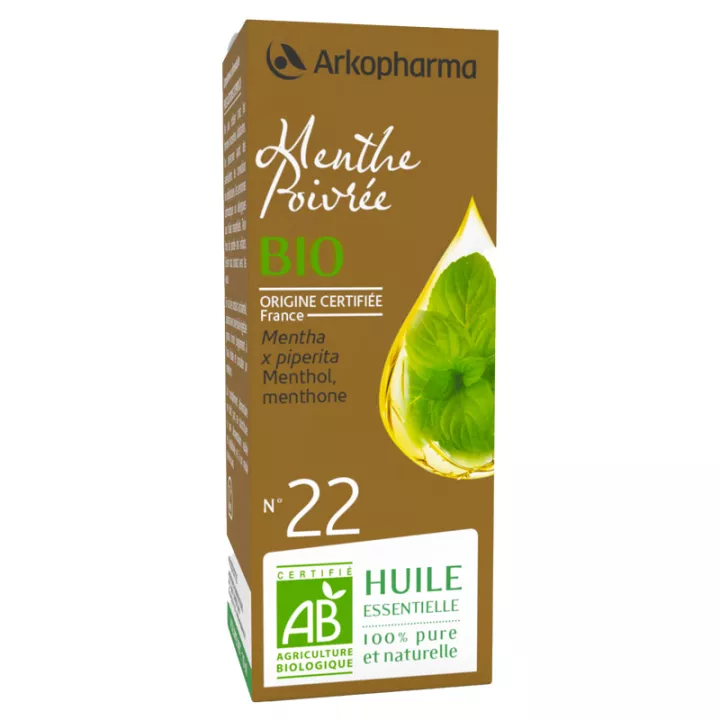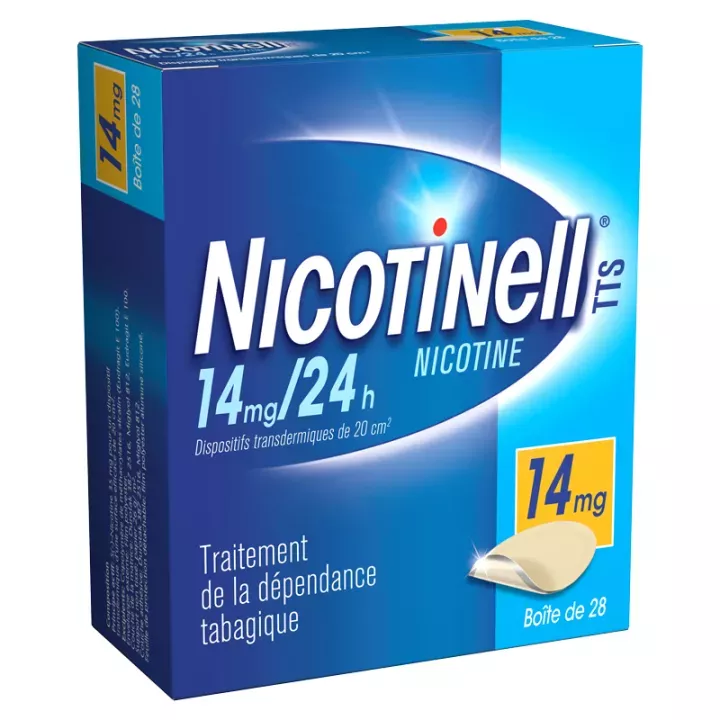NOTICE
ANSM - Last updated: 14/12/2015
Name of the medicinal product
NICOTINELL FRESH MINT 2 mg SUGAR-FREE, medicated chewing gum
Nicotine
framed
Read this leaflet carefully before you start taking this medicine. It contains important information for your treatment.
This medication is a specialty of AUTOMEDIZATION which can be used without consultation or prescription from a doctor.
· Keep this leaflet, you may need to read it again.
· If you need more information and advice, ask your pharmacist.
· If you are still using NICOTINELL FRUIT after 9 months, see a doctor.
· If you notice any side effects not listed in this leaflet, or if you feel any of the side effects gets worse, tell your doctor or pharmacist.
Review summary
In this notice :
1. What is NICOTINELL MENTHE FRESHENER 2 mg SUGAR-FREE, medicated chewing gum and in which cases it is used?
2. What should I know before taking NICOTINELL MENTHE FRESHENER 2 mg SUGAR-FREE, medicated chewing gum?
3. How to take NICOTINELL FRESH MINT 2 mg SUGAR-FREE, medicated chewing gum?
4. What are the possible side effects?
5. How to store NICOTINELL FRESH MINT 2 mg SUGAR-FREE, medicated chewing gum?
6. Additional information.
1. WHAT NICOTINELL MENTHE FRESHENER 2 mg SUGAR-FREE, medicated chewing gum AND WHAT IT IS USED FOR?
Pharmacotherapeutic group
NICOTINELL FRESH MINT 2 mg SUGAR-FREE, medicated chewing gum contains nicotine, one of the tobacco substances.
NICOTINELL FRESH MINT 2 mg SUGAR-FREE, medicated chewing gum belongs to the range of medications to help you quit smoking.
Nicotine is released slowly and then absorbed by buccal absorption every time a gum is chewed.
Therapeutic indications
This drug is indicated for the treatment of tobacco dependence in order to relieve the symptoms of nicotine withdrawal in subjects wishing to stop their tobacco consumption.
Tailored management improves the chances of success in stopping smoking.
2. BEFORE YOU TAKE NICOTINELL FRESH MINT 2 mg SUGAR-FREE, medicated chewing gum?
List of information needed before taking the medication
Not applicable.
Cons-indications
Never take NICOTINELL FRESH MINT 2 mg SUGAR-FREE, medicated chewing gum in the following cases:
· If you are not a smoker,
· In case of allergy to nicotine or to any of the excipients contained in NICOTINELL MENTHE FRAICHEUR 2 mg.
If in doubt, it is essential to seek the advice of your doctor or pharmacist.
Precautions for use; special warnings
Take special care with NICOTINELL FRESH MINT 2 mg SUGAR-FREE, medicated chewing gum
Consult your doctor or pharmacist if you:
· cardiovascular disease, eg myocardial infarction, heart failure, angina pectoris, Prinzmetal angina, heart rhythm disorder,
· history of stroke,
· high blood pressure,
· circulatory problems,
· hepatic or renal insufficiency,
· thyroid disease (hyperthyroidism),
· diabetes (follow your blood glucose more often at the beginning of the treatment as it can be altered),
· pheochromocytoma ( disease of the adrenal glands causing severe hypertension ),
· inflammation of the mouth or throat, esophagitis, gastritis, stomach or duodenal ulcer,
· intolerance to fructose.
Nicotine in small amounts is dangerous in children and can cause severe symptoms or death. This is why it is imperative to keep NICOTINELL MENTHE FRAICHEUR, chewing gum out of the reach and sight of children.
In the event that dental prosthesis wearers have difficulty chewing the gums, it is recommended that treatment be stopped and another pharmaceutical form used. Ask your doctor or pharmacist.
Interaction with other medicines
Taking or using other medicines:
Please tell your doctor or pharmacist if you are taking or have recently taken any other medicines, even medicines obtained without a prescription. If you stop smoking and are taking other medications, your doctor may want to adjust the dosage.
There are no data on possible interactions between NICOTINELL MENTHE FRAICHEUR, gum and other medicines. However, substances in cigarettes, other than nicotine, may have an effect on certain drugs.
Stopping tobacco can affect the action of certain drugs, for example:
· theophylline (a drug used in the treatment of asthma),
· tacrine (a drug used in the treatment of Alzheimer's disease),
· olanzapine and clozapine (drugs used in the treatment of schizophrenia),
· insulin (a drug used in the treatment of diabetes).
May require dose adjustment.
Interactions with food and beverages
Food and drinks
Consumption of coffee, acidic and soft drinks (sodas) may decrease nicotine absorption and should be avoided within 15 minutes of taking a chewing gum.
Interactions with Herbal Medicines or Alternative Therapies
Not applicable.
Use during pregnancy and lactation
Pregnancy
It is very important to stop smoking during your pregnancy as this can lead to a delayed growth of your child or even prematurity or fetal death. Ideally, you should try to stop smoking without taking medication. In case of failure, NICOTINELL MENTHE FRAICHEUR can be advised to help you. Indeed, the risk to the fetus is probably lower than that related to smoking. Nicotine in all its forms can harm your child. NICOTINELL FRESH MINT can be taken only after consulting the doctor who is following your pregnancy or a doctor specializing in smoking cessation help.
feeding
NICOTINELL MINT FRESHNESS Chewing gum, like smoking, should be avoided during breast-feeding because nicotine passes into breast milk.
If your doctor recommends the use of NICOTINELL MINT FRESH, chewing gum during lactation, the gum should be chewed immediately after breastfeeding and not during the two hours before breastfeeding.
Ask your doctor or pharmacist for advice before taking any medicine.
Sport
Not applicable.
Effects on ability to drive or use machines
Driving and using machines:
Stopping smoking can cause behavioral changes. At the recommended doses, there is no particular risk associated with NICOTINELL FRESH MINT 2 mg, medicated chewing gum.
List of excipients with known effect
Important information about some of the ingredients of NICOTINELL MENTHE FRAICHEUR 2 mg SANS SUGAR, medicated chewing gum:
NICOTINELL FRESH MINT 2 mg chewing gum contains sorbitol, source of fructose:
· if you know you are intolerant to certain sugars, consult your doctor before taking this medicine.
The gum contains butylhydroxytoluene (E321) which may cause local irritation of the oral mucosa.
Each gum NICOTINELL MINT FRESH 2 mg contains sugars including 0.2 g of sorbitol (E420), source of fructose (0.04 g / gum). The caloric intake is 1.0 Kcal / gum.
Each chewing gum contains 11.50 mg of sodium, take it into account in people on a diet low in salt.
3. HOW TO TAKE NICOTINELL FRESH MINT 2 mg SUGAR-FREE, medicated chewing gum?
Instructions for proper use
Use NICOTINELL chewing gum as directed in the package leaflet. Ask your doctor or pharmacist for advice in case of doubt.
At initiation and throughout the treatment, complete cessation of tobacco is necessary to increase your chances of success.
NICOTINELL MINT FRESH Gums are available in 2 strengths: 2 mg and 4 mg. The appropriate dose will depend on your smoking habits.
NICOTINELL MINT FRESH 4 mg is recommended:
· for smokers who are highly or very heavily dependent on nicotine,
· in the event of failure after use of the 2 mg dosage,
· if the symptoms of lack remain high with risk of relapse.
In other cases use 2 mg gums.
Choose the appropriate dosage using the table below

If adverse effects are observed with the use of the 4 mg chewing gum, use the 2 mg gums.
Administration mode
ORAL WAY.
· Chew a gum until the taste becomes strong.
· Place the gum between the gum and cheek.
· Repeat chewing gum when taste has faded
· Continue this process until the gum is completely dissolved (about 30 minutes)
DO NOT SWALLOW
Dosage, Mode and / or route (s) of administration, Frequency of administration and Duration of treatment
Dosage in adults over 18 years:
Frequency of Administration
Chew a gum whenever you feel the need to smoke. In general, the initial dose should be 1 gum every 1 to 2 hours. The usual dose is 8 to 12 gums per day. Alternatively, chew a gum whenever you feel an urgent need to smoke. The maximum dose of NICOTINELL MENTHE FRESH 2 mg is 25 gums per day.
Duration of treatment
The duration of the treatment must be adapted individually. Normally, treatment should be continued for at least 3 months. After this time, gradually reduce the number of chewing gums per day; stop treatment when the dose is reduced to 1-2 chewing gums per day. It is generally not recommended to continue treatment beyond 6 months. However, some "ex-smokers" may require longer treatment to avoid relapse.
If you have difficulty in stopping this medication for more than 9 months, seek medical advice.
Advice and follow-up can increase your chances of success.
Children and adolescents under 18 years of age
This medication should not be used without medical advice in subjects younger than 18 years of age.
Symptoms and Instructions for Overdose
If you take more NICOTINELL FRESH MINT 2 mg SUGAR-FREE, medicated chewing gum than you should:
If you chew too many gums you will feel the same signs as if you had smoked too much. These general symptoms of nicotine overdose are: general weakness, sweating, hypersalivation, dizziness, throat irritation, nausea, vomiting, diarrhea, abdominal pain, hearing and vision disorders, headache, palpitations , shortness of breath, prostration, circulatory problems, cardiovascular collapse and seizures that can lead to a fatal outcome.
In this case, inform your pharmacist or doctor.
If you suspect poisoning in a child, contact a doctor or emergency department. Indeed, nicotine in small amounts is dangerous in children and can cause severe symptoms or death.
Instructions for omission of one or more doses
Not applicable.
Risk of withdrawal syndrome
Not applicable.
If you have any further questions on the use of this medication, ask your doctor or pharmacist.
4. WHAT ARE POSSIBLE SIDE EFFECTS?
Description of adverse reactions
Like all medicines, NICOTINELL MENTHE FRESHENER 2 mg SUGAR-FREE, medicated chewing gum is likely to have side effects, although not everyone is subject to it.
Some side effects such as dizziness, headaches and insomnia may occur at the start of treatment and may be due to symptoms of withdrawal associated with smoking cessation or nicotine underdosing.
Common side effects (affecting 1 to 10 people out of 100)
· Headache, dizziness.
· Hiccups, digestive upset, nausea, flatulence, vomiting, heartburn, hypersalivation, irritation of the mouth and throat, jaw pain may occur, especially if you chew gums too quickly.
These symptoms can be relieved by chewing the gums more slowly.
Uncommon side effects (affecting 1 to 10 people per 1,000)
· Palpitations.
· Redness of the skin and urticaria.
Uncommon side effects (affecting 1 to 10 people out of 10,000)
· Heart rhythm disorders (accelerated heart rate) and allergic reactions. Allergic reactions may be in very rare cases with the following symptoms: swelling of the skin, swelling of the face and mouth, dizziness, dizziness and fainting (symptoms of hypotension).
If any of these symptoms occur, discontinue use of NICOTINELL gums and contact your doctor immediately.
Mouth ulcers can occur when smoking cessation, but their relationship to nicotine therapy is not established.
In case of adhesion, NICOTINELL gums can in rare cases cause alteration of dental prostheses or amalgams.
If you notice any side effects not listed in this leaflet, or if any of the side effects gets serious, contact your doctor or pharmacist.
5. HOW TO STORE NICOTINELL FRESH MINT 2 mg SUGAR-FREE, medicated chewing gum?
Keep out of the reach and sight of children.
Expiration date
Do not use after the expiry date stated on the carton. The expiry date refers to the last day of the month.
After use, pay attention to where you throw your chewed gum.
Storage conditions
Store at a temperature not exceeding 25ºC.
If necessary, warnings against visible signs of deterioration
Medicines should not be disposed of via wastewater or household waste. Ask your pharmacist what to do with unused medications. These measures will help protect the environment.
6. ADDITIONAL INFORMATION
Full list of active substances and excipients
What does NICOTINELL MENTHE FRESHEN 2 mg containing SUGAR, medicated chewing gum contains?
The active substance is :
Nicotine ................................................. .................................................. ..................................... 2,000 mg
In the form of nicotine-polacriline (1: 4) ....................................... .................................................. .. 10.00 mg
For a chewing gum.
The other components are :
Gum base (containing butylhydroxytoluene (E321)), calcium carbonate, sorbitol (E420), anhydrous sodium carbonate, sodium bicarbonate, polacriline, glycerol (E422), purified water, levomenthol, natural mint fragrance , acesulfame potassium, xylitol (E967), mannitol (E421), gelatin, titanium dioxide (E171), Carnauba wax, talc.
Pharmaceutical form and content
What is NICOTINELL MENTHE FRESHENER 2 mg SUGAR-FREE, medicated chewing gum and contents of the pack?
This medicine is in the form of rectangular white medicated chewing gums. Boxes of 2, 12, 24, 36, 48, 60, 72, 96, 120 or 204.
Name and address of the marketing authorization holder and the holder of the manufacturing authorization responsible for the release of the lots, if different
Holder
GLAXOSMITHKLINE HEALTH GRAND PUBLIC
100 ROUTE OF VERSAILLES
CS 80001
78164 MARLY-LE-ROI CEDEX
exploiting
GLAXOSMITHKLINE HEALTH GRAND PUBLIC
100 ROUTE OF VERSAILLES
CS 80001
78164 MARLY-LE-ROI CEDEX
Maker
FAMAR SA
48TH KM NATIONAL ROAD ATHENS-LAMIA
19011 AVLONAS, ATTIKI
GREECE
Names of the medicinal product in the Member States of the European Economic Area
This medicinal product is authorized in the Member States of the European Economic Area under the following names:
In accordance with the regulations.
Date of approval of the notice
The last date on which this leaflet was approved is {date}.
AMM under exceptional circumstances
Not applicable.
Internet Information
Detailed information on this medicine is available on the Afssaps website (France).
Information for health professionals only
Not applicable.
Other
COUNCIL / HEALTH EDUCATION
As soon as you stop smoking
You will no longer absorb the irritating and toxic substances of the cigarette.
You will see some improvements: progressive disappearance of the headaches, the cough, the irritation of the throat, the shortness of breath.
You will often have the satisfaction of getting better sleep, food flavor, odor and improve your physical performance.
You will decrease your risk of developing lung cancer or cardiovascular disease.
It's never too late to quit even if you've smoked a long time and a lot. |
What is tobacco dependence?
Tobacco addiction is twofold:
· Psychological dependence:
Smoking a cigarette involves a ritual of automatic and repetitive gestures associated with particular circumstances (pleasure, response to stress, intellectual stimulation, support for morale, need for a gesture of conviviality). This is psychological and behavioral dependence.
· Physical dependence
The need for the nicotine body is due to the effects of this substance on the nervous system. This is physical dependence. Failure to satisfy this need results in a sense of lack (see description in the chapter "How to overcome your physical dependence?").
Nicotinic substitutes aim to treat this dependence.
How to overcome your psychological addiction?
Stopping smoking is necessary to increase your chances of success, but more:
· Choose a J day in the period that you think is the most favorable.
· Throw away your last pack of cigarettes, your lighter and put away your ashtrays.
· In a couple of smokers, it is preferable that the attempt to stop is made at the same time by both spouses.
Tell your family and co-workers that you quit smoking. Ask them to respect your decision (no smoking near you, no longer offering you cigarettes).
Prepare yourself to cope with the desire to smoke. It may occur suddenly and severely, especially during the first few weeks after the cessation of smoking, but does not last more than 3 or 4 minutes.
You have to anticipate what you will do in this case and act very quickly so as not to "crack" as for example:
· drink a large glass of water,
· to chew gum,
· counting up to 100,
· do some deep breaths,
· out of the room,
· change activity ...
Avoid situations associated with taking cigarettes (coffee, aperitif, ...), avoid temptations (settle with non-smokers).
Find cigarette compensation (leisure, sport, cultural activity ...).
How to overcome your physical addiction?
If you are addicted to nicotine, the success of your approach may require the use of nicotine substitutes.
In order to assess your level of dependence, the Fagerström test is offered.
FAGERSTROM TEST
How long after you wake up do you smoke your first cigarette? | |
within 5 minutes: 3
from 6 to 30 minutes: 2
from 31 to 60 minutes: 1
after 60 minutes: 0 |
Do you find it difficult to not smoke in places where it is forbidden? | |
Yes: 1
no: 0 | |
What cigarette of the day would it be the most difficult for you to give up? | |
the first: 1
another: 0 |
How many cigarettes do you smoke per day? | |
10 or less: 0
11 to 20: 1
21 to 30: 2
31 or more: 3 |
Do you smoke at a more sustained pace in the morning than in the afternoon? | |
Yes: 1
no: 0 |
Do you smoke when you are so sick that you have to stay in bed almost all day? | |
Yes: 1
no: 0 |
TOTAL POINTS | |
score 0 to 2: you are not addicted to nicotine.
You can stop smoking without the need for nicotine replacement.
If you are concerned about this decision, consult your pharmacist or doctor.
score 3 to 4: you are weakly dependent on nicotine.
score 5 to 6: you are moderately addicted to nicotine.
The use of nicotine substitutes will increase your chances of success.
Consult with your pharmacist or doctor to help you choose the treatment best suited to your situation.
score 7 to 10: you are strongly or very strongly dependent on nicotine.
The use of nicotine substitutes is recommended to help you overcome this addiction to nicotine. This treatment should be used in sufficient and appropriate dosage.
Consult with your pharmacist or doctor, possibly as part of a specialized smoking cessation counseling.
Weaning-related disorders may persist for a long time and the duration of treatment should be sufficient, usually one to three months.
If you feel despite the treatment, a persistent lack of feeling like especially:
· compelling need to smoke,
· irritability, sleep disturbances,
· agitation or impatience,
· difficulty of concentration,
Take the advice of your doctor or pharmacist as doses may need to be adjusted.
How do you get help?
Support from health professionals
The support, advice and follow-up that your doctor or pharmacist can give you will be valuable during the first six months of your smoking cessation. You can also use a specialized smoking cessation counseling, especially if you have already failed.
Psychological support
Stopping smoking requires a supportive family and social environment. If you are concerned that the difficulties are too great, psychological support or temporary treatment can help.
Dietetics
In the months following tobacco cessation, you may find moderate weight gain.
If you have any concerns in this area, you can contact a health professional who will be able to advise you.
You started smoking again, why?
Consider this relapse as an accident of course, as a normal event that allows to learn: the relapse is not a failure.
Analyze the reasons why you took back the tobacco.
· Because of the physical dependence
This may have been poorly taken into account or reappeared after several months, occasionally, for example, by prolonged stays in smoky atmospheres.
· Because of excessive weight gain.
It may be necessary to change your diet somewhat before your next attempt to quit smoking.
· Because of a decline in motivation , because of a painful event or a difficult period, because of psychological difficulties appearing at the cessation of smoking (depression, anxiety ...), because of a situation very tempting. Understand the reason for this relapse to prevent it if possible during the next attempt.
In all cases, do not hesitate to ask for advice from a health professional or to use a specialized consultation to help with smoking cessation.
If you have started smoking again, do not get discouraged, experience shows that your chances of success increase after one or more attempts to quit. |




















